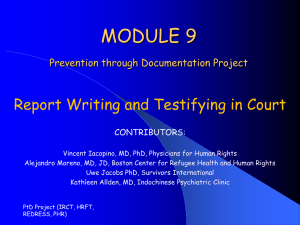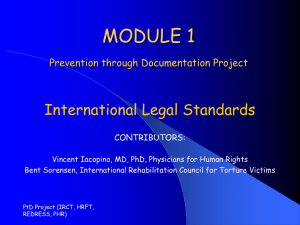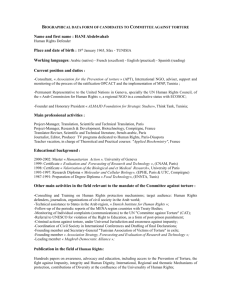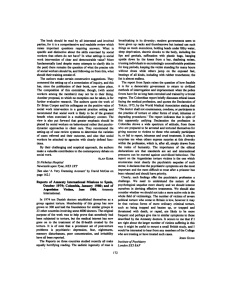Module 7: Case Example #01
advertisement
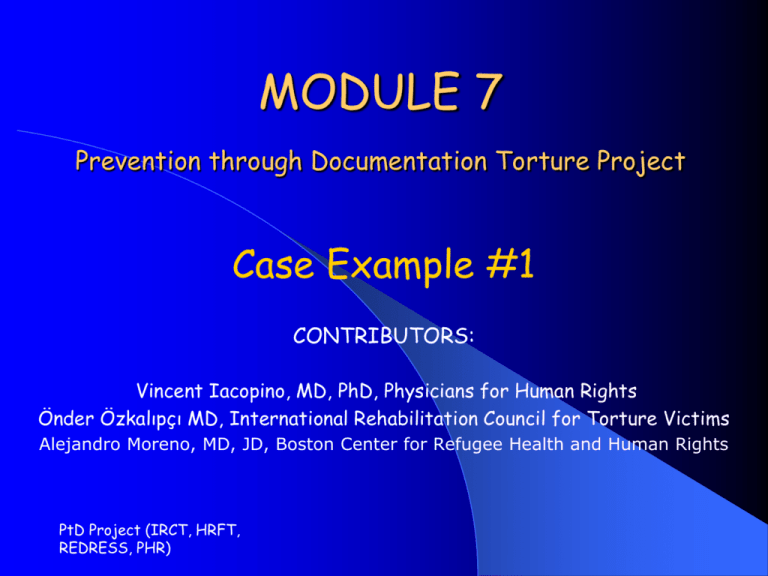
MODULE 7 Prevention through Documentation Torture Project Case Example #1 CONTRIBUTORS: Vincent Iacopino, MD, PhD, Physicians for Human Rights Önder Özkalıpçı MD, International Rehabilitation Council for Torture Victims Alejandro Moreno, MD, JD, Boston Center for Refugee Health and Human Rights PtD Project (IRCT, HRFT, REDRESS, PHR) Case #1 Outline for Demonstration Role-play interview Interview divided into 8 components – Learning objectives for each component Time-outs: A break in the interview action used to make teaching points PtD Project (IRCT, HRFT, REDRESS, PHR) Interview Components Introduction – Conditions of interview – Identification information Past history – Medical, surgical, psychosocial (Pre-Arrest) Trauma history Review of torture methods Physical symptoms (acute & chronic) and disabilities Psychological assessment and mental status examination Physical examination Interpretation of findings & conclusions PtD Project (IRCT, HRFT, REDRESS, PHR) Case Summary/Referral #1 Name Name: Mrs. Asha Ali Yousif Date Reporting to the Center: dd/mm/yyyy Date of Birth: dd/mm/yyyy Age: 35 years-old Marital Status/Children: Married, widow, 13 year-old daughter Religion: Muslim Ethnic Group: Fur Profession: Teacher Political/Social Affiliation: None Date and Place of Detention/Assault: dd/mm/yyyy in a field 2 Km east of Kalma Camp; dd/mm/yyyy at Nyala Wasat (Central) police station. Period of Detention: Less than 2 hours on both occasions PtD Project (IRCT, HRFT, REDRESS, PHR) Case Summary/Referral #01 Trauma History: – On dd/mm/yyyy 2:00pm – Mrs. Yousif, her 13 year-old daughter, and two other women – – – – – – – fetching firewood Attacked by armed men in military uniforms All beaten and raped One woman, Fatima Ibrahim (22 yrs), shot and killed Days later, Mrs. Yousif reported incident to police. Police refused to file case One police officer, Omer Mohamed Suliman, beat and sexually assaulted her Mrs. Yousif went to went to Nyala Hospital, but was refused a medico-legal evaluation since she did not have Police Form 8 Friend in Kalma worried about her and insisted that she get help. The friend also suggested that Mrs. Yousif and her daughter take legal action against their perpetrators. PtD Project (IRCT, HRFT, REDRESS, PHR) Case Summary/Referral #1 Alleged Perpetrators: Men in military uniform, also, police officer Omer Mohamed Suliman from Nyala Wasat (Central) Police Station. Reasons for visit: Mrs. Yousif indicated that she would like to get help for her daughter and herself, but she was not sure about taking legal action against their perpetrators. Effects of Torture: Insomnia, nightmares, inability to concentrate, profound sadness, frequent headaches and decreased appetite. She is also very troubled about her daughter’s health and future. PtD Project (IRCT, HRFT, REDRESS, PHR) Begin Interview PtD Project (IRCT, HRFT, REDRESS, PHR) 1. Introduction/Conditions of Interview & Identification Information Learning Objectives – Provide clear and effective introduction: identity of examiner, – – – – – – purpose of interview, who medical evaluation will be sent to and limitations on confidentiality Explain nature of evaluation and simultaneous need for detail and accuracy. Uncertainties should be discussed due to likely adverse effect on credibility. Obtain informed consent on Standard Evaluation Form (#1-3) Ensure comfortable stetting, respectful interaction Earn trust, establish alleged victim’s control over interview process Ability to accurately record relevant case information Develop appropriate responses to police coercion PtD Project (IRCT, HRFT, REDRESS, PHR) 2. Past Medical and Surgical History & Psychosocial History – Pre-Arrest Learning Objectives – Obtain a complete medical history, including prior medical, surgical and/or psychiatric problems – Document any history of injuries before period of detention and any possible after-effects. Knowledge of prior injuries may help differentiate scars, or other physical evidence, related to torture from those that are not – Summarise any previous forensic evaluation related to allegations of torture and/or ill treatment PtD Project (IRCT, HRFT, REDRESS, PHR) 3. Trauma History Learning Objectives – Understand various techniques of questioning and apply them – – – – – appropriately Elicit a coherent and accurate account of alleged torture/ill treatment Structure inquiries to elicit a chronological account of events experienced Understand sources of variability and effect of such variability on history taking Pursue and clarify possible inconsistencies in the trauma history Take note of non-verbal (process) information and links between emotional affect and content of trauma history PtD Project (IRCT, HRFT, REDRESS, PHR) 4. Review of Torture Methods Learning Objectives – Understand advantages and disadvantages of direct questions about specific methods of torture/ill treatment – Assess a wider range of possible physical and psychological methods of torture PtD Project (IRCT, HRFT, REDRESS, PHR) 5. Physical Symptoms (acute and chronic) and Disabilities Learning Objectives – Assess relevant physical symptoms (acute and chronic) and disabilities experienced after alleged torture/ill treatment – Anticipate physical symptoms and/or disabilities for specific methods of alleged torture – Correlate reported physical symptoms (acute and chronic) and disabilities with specific allegations of abuse PtD Project (IRCT, HRFT, REDRESS, PHR) 6. Psychological Assessment and Mental Status Examination Learning Objectives – Conduct a mental status examination – Be aware of factors that may contribute to psychological – – – – outcomes Assess symptoms of common psychological conditions associated with torture and ill treatment. Recognise signs and symptoms of possible organic brain dysfunction Recognise and respond effectively to transference and countertransference reactions Recognise and respond effectively in court when asked qualifications of physician to conduct a psychological evaluation PtD Project (IRCT, HRFT, REDRESS, PHR) 7. Physical Examination Learning Objectives – Recognise physical signs of torture/ill treatment in acute and – – – – chronic settings and understand sensitivity and specificity of common findings Anticipate pertinent positive and negative findings based on specific allegations of torture and/or descriptions of acute/chronic symptoms or disabilities following torture or ill treatment Understand the advantages and disadvantages of conducting complete vs. directed physical examinations Understand how mitigating factors may affect physical sequelae of torture and ill treatment Document photographic evidence where appropriate and make effective use of anatomical drawings PtD Project (IRCT, HRFT, REDRESS, PHR) Virtual Physical Examination Cases #1 Cases Developed by Vincent Iacopino, MD, PhD, Alejandro Moreno, MD, JD, and Önder Özkalıpçı, MD Case #1 35 year-old female alleging: – Sexual Assault – Head trauma – Laceration injury to the dorsum (backside) of the left hand The following photographs were taken at the time of the current evaluation. Case #01 8. Interpretation of Findings and Conclusions Learning Objectives: – Provide interpretations on physical, psychological and, if relevant, historical evidence of torture/ill treatment – State unequivocally in the conclusion the student’s opinion on possibility of torture and/or ill treatment, and indicate degree of certainty. Consider recommendations in Istanbul Protocol – Provide appropriate recommendations for further evaluations and treatment PtD Project (IRCT, HRFT, REDRESS, PHR) Debriefing Role-players provide feedback on student performances and process issues Consider relevant transference and countertransference issues PtD Project (IRCT, HRFT, REDRESS, PHR)
